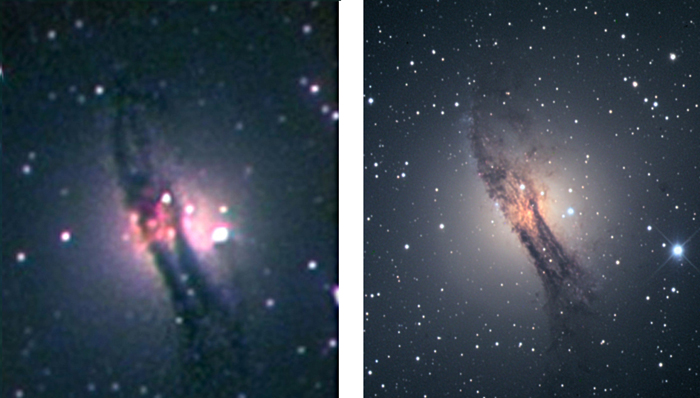
Advanced Telescope Supplies
Australia's Premier CCD and Astro-Imaging Experts
CCD Imaging for beginners.

The above pair of images of the Galaxy known as NGC 5128 graphically illustrate the difference that equipment and software can make to a CCD image. But, oh dear! What happened to the image on the left? Many beginners blissfully take pictures like this one (taken with a single shot colour CCD camera), and, well, are happy with the results.
The image on the right shows what is possible using amateur equipment from sub-urban backyards. Even before you purchase a CCD camera, there are several elements that are essential to all good CCD images. These are:
A smooth stable equatorial mounting, Quality optics, Careful attention to telescope polar alignment and focusing, careful attention to guiding.
Assuming you have all the above squared away, you are still probably wondering, "Yes, but how do I use a CCD camera with MY telescope?" The image above was taken through a 3" refractor. As can be seen, you don't need a large telescope to take great images.
Apart from a CCD camera, you will need:
A computer. Typically IBM PC compatible, running the latest incarnation of Windows (98,200,ME, NT, XP are all fine). If your computer can run Windows, it will be powerful enough to run the CCD software that should come with your camera. A laptop computer is very handy if you intending on using your CCD camera the field.
Power supply. Many CCD cameras require a Mains A/C outlet, however car batteries and DC inverters can be used as substitutes.
Don't forget your telescope probably needs 12VDC for its drive system as well!
Your CCD camera will usually plug into the printer ports or USB port of your PC. The camera itself is attached to the telescope either by its 1.25" or 2" eyepiece holder, or sometimes via a T-thread. If the camera is self-guiding, it will have an auto-guider cable which plugs into the auto-guider port of the telescope.
Then it is a matter of powering up computer and CCD camera, and starting the camera's control software. Images taken through the camera will appear on the computer screen. As the images are fully digital, they take time to "download". The download time depends upon the type of connection (USB is usually the fastest), and interface used by the CCD, but typically takes just a few seconds.
Once the image appears on the screen, you can save it to the computer's hard drive, or delete it and try again. The longer the exposure, the fainter the objects your camera will detect plus the image will have less electronic "noise". The downside is your telescope will have to track more accurately for longer exposures.
By the way, your first few images will probably look like the one on the above left, but don't worry, as you get more familiar with your equipment, you will be able to hone your CCD imaging techniques, and provided you have purchased wisely, start taking pictures more like the one on the right.
Some equipment recommendations: First CCD camera, consider the new ST8300 (about $A2850). It has very high speed downloads, easy to use software and an impressive 8 megapixel CCD array. If you want to do colour imaging, you will need a colour filter wheel (add about $A1550). Please feel free to call or e-mail us for other CCD recommendations.